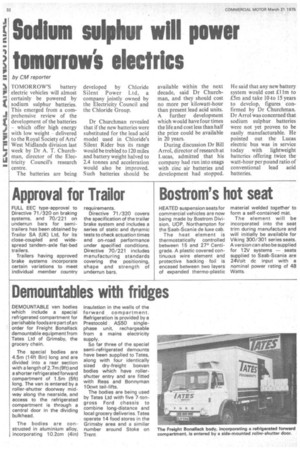Sodium sulphur will power tomorrow's electrics
Page 34

If you've noticed an error in this article please click here to report it so we can fix it.
by CM reporter
TOMORROW'S battery electric vehicles will almost certainly be powered by sodium sulphur batteries. This emerged from a comprehensive review of the development of the batteries which offer high energy with low weight delivered to the Royal Society of Arts' West Midlands division last week by Dr A. T. Churchman, director of the Electricity Council's research centre.
The batteries are being developed by Chloride Silent Power Ltd, a company jointly owned by the Electricity Council and the Chloride Group.
Dr Churchman revealed that if the new batteries were substituted for the lead acid model used in Chloride's Silent Rider bus its range would be trebled to 120 miles and battery weight halved to 2.4 tonnes and acceleration would also be improved. Such batteries should be available within the next decade, said Dr Churchman, and they should cost no more per kilowatt-hour than present lead acid units. A further development which would have four times the life and cost less than half the price could be available in 20 years.
During discussion Dr Bill Arrol, director of research at Lucas, admitted that his company had run into snags with zinc air batteries and development had stopped. He said that any new battery system would cost £1 lm to £5m and take 104o 15 years to develop, figures confirmed by Dr Churchman. Dr Arrol was concerned that sodium sulphur batteries were not yet proven to be easily manufacturable. He pointed out the Lucas electric bus was in service today with lightweight batteries offering twice the watt-hour per pound ratio of conventional lead acid batteries.








































































































































